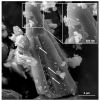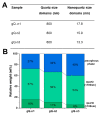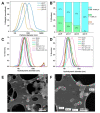Top-Down Preparation of Nanoquartz for Toxicological Investigations
- PMID: 36499757
- PMCID: PMC9738116
- DOI: 10.3390/ijms232315425
Top-Down Preparation of Nanoquartz for Toxicological Investigations
Abstract
Occupational exposure to quartz dust is associated with fatal diseases. Quartz dusts generated by mechanical fracturing are characterized by a broad range of micrometric to nanometric particles. The contribution of this nanometric fraction to the overall toxicity of quartz is still largely unexplored, primarily because of the strong electrostatic adhesion forces that prevent isolation of the nanofraction. Furthermore, fractured silica dust exhibits special surface features, namely nearly free silanols (NFS), which impart a membranolytic activity to quartz. Nanoquartz can be synthetized via bottom-up methods, but the surface chemistry of such crystals strongly differs from that of nanoparticles resulting from fracturing. Here, we report a top-down milling procedure to obtain a nanometric quartz that shares the key surface properties relevant to toxicity with fractured quartz. The ball milling was optimized by coupling the dry and wet milling steps, using water as a dispersing agent, and varying the milling times and rotational speeds. Nanoquartz with a strong tendency to form submicrometric agglomerates was obtained. The deagglomeration with surfactants or simulated body fluids was negligible. Partial lattice amorphization and a bimodal crystallite domain size were observed. A moderate membranolytic activity, which correlated with the number of NFS, signaled coherence with the previous toxicological data. A membranolytic nanoquartz for toxicological investigations was obtained.
Keywords: crystallinity; fracturing; milling; nanoparticle; quartz; silanol; silica.
Conflict of interest statement
The authors declare that the research was conducted in the absence of any commercial or financial relationships that could be construed as potential conflicts of interest.
Figures








Similar articles
-
Revisiting the paradigm of silica pathogenicity with synthetic quartz crystals: the role of crystallinity and surface disorder.Part Fibre Toxicol. 2016 Jun 10;13(1):32. doi: 10.1186/s12989-016-0136-6. Part Fibre Toxicol. 2016. PMID: 27286702 Free PMC article.
-
Nearly free surface silanols are the critical molecular moieties that initiate the toxicity of silica particles.Proc Natl Acad Sci U S A. 2020 Nov 10;117(45):27836-27846. doi: 10.1073/pnas.2008006117. Epub 2020 Oct 23. Proc Natl Acad Sci U S A. 2020. PMID: 33097669 Free PMC article.
-
Ζ potential evidences silanol heterogeneity induced by metal contaminants at the quartz surface: Implications in membrane damage.Colloids Surf B Biointerfaces. 2017 Sep 1;157:449-455. doi: 10.1016/j.colsurfb.2017.06.012. Epub 2017 Jun 13. Colloids Surf B Biointerfaces. 2017. PMID: 28646781
-
The quartz hazard: effects of surface and matrix on inflammogenic activity.J Environ Pathol Toxicol Oncol. 2001;20 Suppl 1:109-18. J Environ Pathol Toxicol Oncol. 2001. PMID: 11570668 Review.
-
Bioreactivity of the crystalline silica polymorphs, quartz and cristobalite, and implications for occupational exposure limits (OELs).Crit Rev Toxicol. 2013 Sep;43(8):632-60. doi: 10.3109/10408444.2013.818617. Epub 2013 Jul 18. Crit Rev Toxicol. 2013. PMID: 23863112 Review.
Cited by
-
Physico-chemical features and membranolytic activity of dust from low or no crystalline silica engineered stone with implications for toxicological assessment.Sci Rep. 2025 Jul 15;15(1):25451. doi: 10.1038/s41598-025-10460-w. Sci Rep. 2025. PMID: 40659737 Free PMC article.
-
Physico-Chemical Approaches to Investigate Surface Hydroxyls as Determinants of Molecular Initiating Events in Oxide Particle Toxicity.Int J Mol Sci. 2023 Jul 14;24(14):11482. doi: 10.3390/ijms241411482. Int J Mol Sci. 2023. PMID: 37511241 Free PMC article. Review.
References
-
- Cullinan P., Muñoz X., Suojalehto H., Agius R., Jindal S., Sigsgaard T., Blomberg A., Charpin D., Annesi-Maesano I., Gulati M. Occupational lung diseases: From old and novel exposures to effective preventive strategies. Lancet Respir. Med. 2017;5:445–455. doi: 10.1016/S2213-2600(16)30424-6. - DOI - PubMed
-
- Iler K.R. The Chemistry of Silica: Solubility, Polymerization, Colloid and Surface Properties and Biochemistry of Silica. Wiley-Interscience; New York, NY, USA: 1979.
-
- International Agency for Research on Cancer (IARC) A Review of Human Carcinogens: Arsenic, Metals, Fibres, and Dusts. Volume 100C IARC; Lyon, France: 2012. - PubMed
MeSH terms
Substances
Grants and funding
LinkOut - more resources
Full Text Sources
Medical

